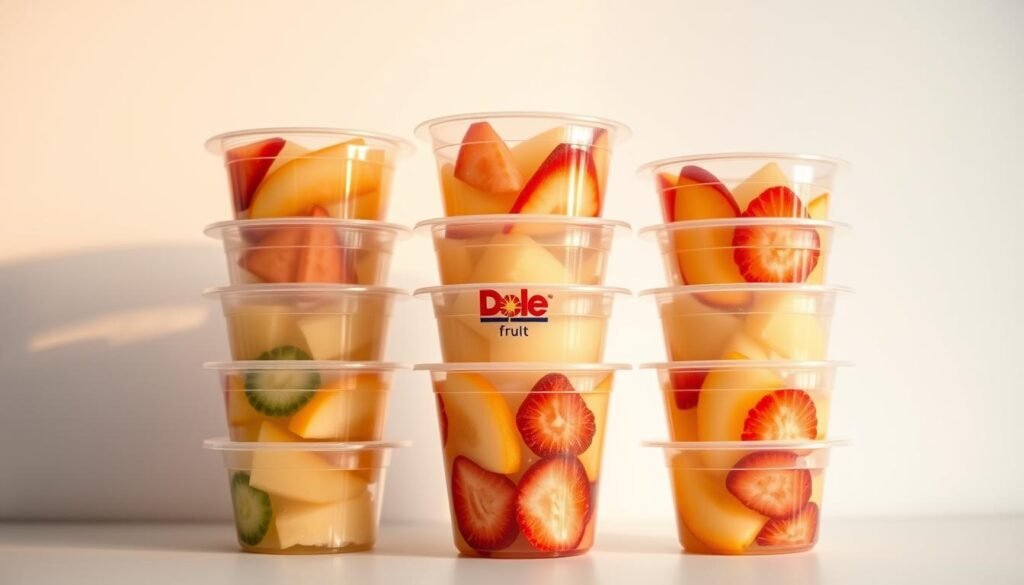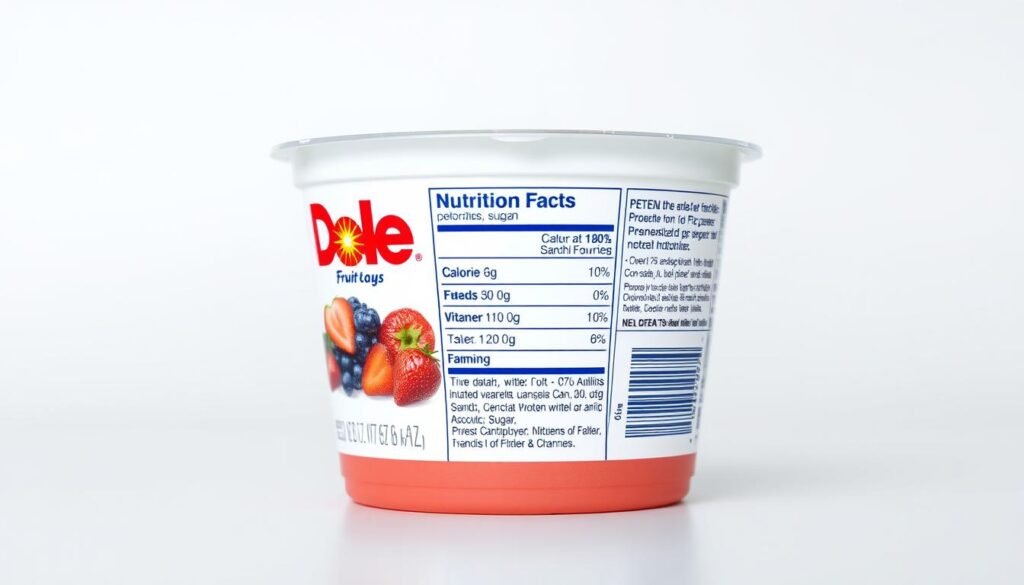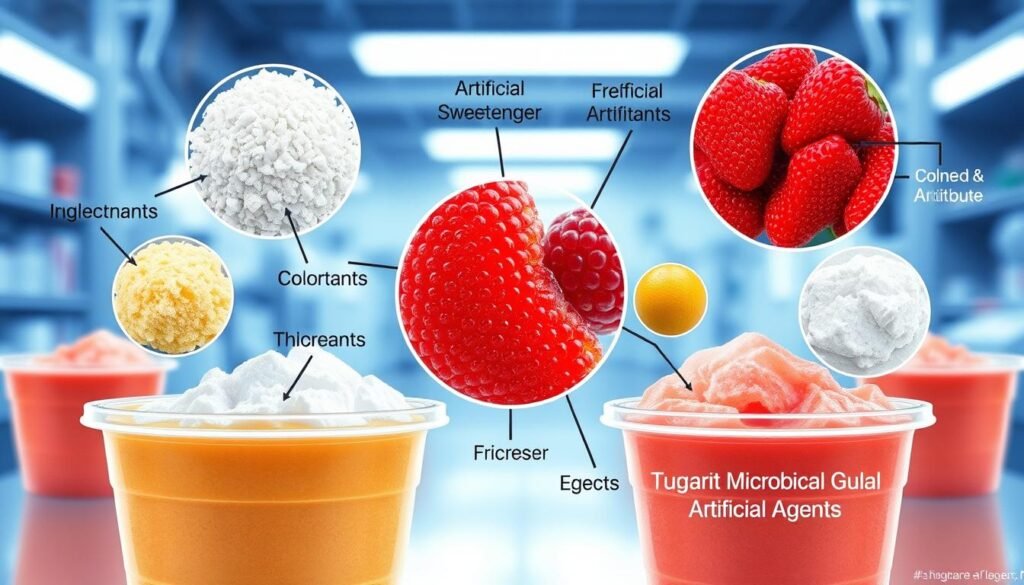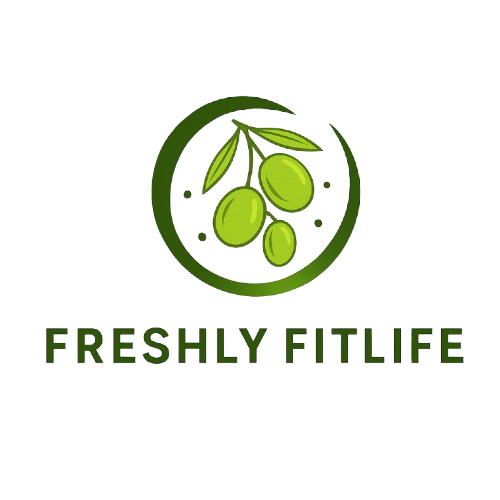Ever grabbed a prepackaged fruit cup for a quick snack, wondering if it’s as good as fresh produce? Many shoppers pick these convenient options, but hidden ingredients might surprise you.
Dole dominates the market with its wide range of fruit cups, but not all varieties offer the same benefits. Some contain added sugars or syrups, while others keep it simple. How do they compare to whole, fresh alternatives?
This guide breaks down five key factors: nutritional value, sugar content, additives, fresh comparisons, and the best picks. Let’s dive in!
Key Takeaways
- Prepackaged options save time but may include hidden sugars.
- Syrup-packed versions often lack the fiber of fresh produce.
- Check labels for preservatives and artificial ingredients.
- Some varieties offer lighter, juice-based alternatives.
- Fresh fruit typically provides more vitamins and fewer additives.
Introduction: Are Dole Fruit Bowls a Smart Snack Choice?
Busy lifestyles make grab-and-go options like fruit cups tempting. They’re portable, shelf-stable, and require no prep—perfect for rushed mornings or lunchboxes. But does convenience come at a cost?

A surprising paradox exists: 72% of parents view these cups as a healthy snack, yet many varieties pack added sugars. The American Heart Association warns that excess sugar harms children’s health, linking it to obesity and heart disease.
Modern snacking habits amplify the issue. Over 60% of Americans prioritize speed over nutrition, according to recent surveys. Some fruit cups contain as much sugar as a soda—a shocking fact masked by their wholesome image.
USDA guidelines recommend whole fresh fruit for maximum benefits. While packaged options help when fresh isn’t available, reading labels is crucial. The next section reveals how sugar and additives stack up.
Are Dole Fruit Bowls Healthy? A Nutritional Breakdown
Peeling back the label shows what these convenient snacks truly deliver. A standard 4oz serving packs 70 calories, but the macros reveal imbalances. With 16g sugars and under 1g fiber, they’re far from whole-fruit equivalents.

Calories and Macronutrients
Each cup contains 17g carbs—mostly from sugars. Zero fat and minimal protein make them quick energy bursts without lasting fullness. Fresh alternatives, like bananas, offer potassium and 3–4g fiber per serving.
Fiber Content and Digestive Health
Processed options lose natural fiber during packaging. The
Vitamins and Minerals in Dole Fruit Cups
Ascorbic acid preserves vitamins like C, but heat processing reduces others. A fresh orange delivers 90mg vitamin C; syrup-packed cups provide just 30mg. Minerals like potassium also drop by 50% compared to whole fruit.
While convenient, dole fruit cups often trade nutrition for shelf life. Opt for juice-packed versions or pair them with nuts to balance macros.
Understanding Sugar Content in Dole Fruit Cups
Sugar lurks in unexpected places—even in seemingly wholesome convenience foods. While natural sugars occur in whole produce, many packaged versions sneak in added sugars or syrups. A single cup can contain 16g total sugars, rivaling some sodas.

Natural Sugars vs. Added Sugars
Fruit contains fructose, a natural sugar paired with fiber and nutrients. Processed cups often use concentrates, boosting sugar density without the benefits. For example, “100% juice” labels may still mean 22g sugars—close to a Coke’s 24g.
High Fructose Corn Syrup and Health Risks
Some varieties include high fructose corn syrup, linked to liver strain when overconsumed. Unlike natural sugars in whole fruit, this additive spikes blood sugar faster. Visualize one cup’s sugar as four packed teaspoons.
American Heart Association Guidelines on Sugar
The American Heart Association caps daily added sugars at 6 tsp (women) or 9 tsp (men). Many cups exceed half this limit in one serving. Opt for no-sugar-added versions or fresh fruit to stay within bounds.
Additives and Preservatives: What’s Inside?
What’s really hiding in that convenient snack? Many packaged options rely on additives preservatives to stay fresh. While some are harmless, others spark debates among health-conscious consumers.

Common Preservatives Like Ascorbic Acid
Vitamin C, listed as ascorbic acid, prevents browning and boosts shelf life. Citric acid adds tartness and fights bacteria. Both are generally safe, but reactions with sodium benzoate may form trace benzene—a risk tightly regulated by the FDA.
Artificial Sweeteners and Their Effects
Some varieties swap sugar for artificial sweeteners like sucralose. It’s 600x sweeter than sugar, yet studies debate its long-term impact. Monk fruit or stevia offer natural alternatives with fewer concerns.
Are There Harmful Chemicals?
Most chemicals in these snacks carry GRAS (Generally Recognized As Safe) status. However, controversial sweeteners or corn syrup in syrup-packed versions may warrant caution. Always check labels for transparency.
“The FDA’s GRAS list ensures additives meet safety standards, but moderation remains key.”
Opt for no-sugar-added or juice-packed versions to minimize exposure. Pairing them with nuts or yogurt balances macros and offsets any downsides.
Dole Fruit Bowls vs. Fresh Fruit: Which Wins?
Fresh or packaged? The debate over snacking choices is hotter than ever. While grab-and-go options save time, whole fresh fruit delivers unmatched nutrient retention. Let’s break down the showdown.
Nutrient Retention in Fresh vs. Packaged
Processing strips away benefits. Heat pasteurization cuts vitamin C by 40% in packaged options. A fresh orange offers 90mg; syrup-packed cups provide just 30mg.
Fiber also drops. Whole apples have 4g fiber—cups average under 1g. Minerals like potassium fade by half during shelf-life extensions.
Convenience vs. Nutritional Value
Prepackaged snacks win for portability but lose on balance. Consider:
| Factor | Fresh Fruit | Packaged Cups |
|---|---|---|
| Fiber (per serving) | 3–4g | 0–1g |
| Vitamin C | High (unaltered) | Reduced by 40% |
| Prep Time | Washing/peeling | Instant |
Environmental Impact of Packaging
Single-use plastics in packaging create 5x the carbon footprint of compostable peels. Yet, food waste complicates the math:
- 20% of fresh fruit spoils before eating.
- Packaged options waste just 2% but linger in landfills.
Switching to bulk buys saves $156 yearly—and reduces trash. Reserve cups for camping or emergencies.
Best and Worst Dole Fruit Cup Varieties
Not all packaged snacks are created equal—some Dole options outshine others. The brand offers over 15 varieties, ranging from nutritionally dense to sugar-loaded. Smart shoppers should know which picks support their goals and which to avoid.
No Sugar Added: The Healthiest Option
The no sugar added line tops the list at just 40 calories per cup. Sweetened with stevia, these cups provide a mildly herbal aftertaste but skip the blood sugar spikes. They retain most natural vitamins since they’re packed in water or natural juices.
Compared to syrup versions, these offer:
- 60% fewer calories
- Zero added sugars
- Higher vitamin C retention
Avoiding Syrup-Packed and Gel Varieties
Gel-based cups and those soaked in heavy syrup rank lowest. A single serving can hide 22g sugar—equal to five teaspoons. Kids’ versions often worsen this, containing 50% more sweeteners than adult lines.
“‘Fruit juice concentrate’ on labels often means added sugar—a loophole many parents miss.”
Mixed Fruit Cups: A Middle Ground?
Tropical mixes like pineapple-mango offer a variety of nutrients in one cup. While some contain light syrups, their diverse fruit profiles provide broader health benefits than single-fruit options. Check labels—juice-packed versions beat syrup alternatives.
Watch for serving size tricks: some cups list 2.5 servings per container. Always verify nutrition facts per actual portion.
How to Incorporate Dole Fruit Bowls into a Balanced Diet
Smart snacking means balancing convenience with nutrition—here’s how to do it right. Prepackaged options can work in a balanced diet, but strategy matters. Focus on three pillars: smart portions, nutrient combos, and knowing when to swap for fresh.
Portion Control and Moderation
Keep servings in check. One cup (4oz) is a single portion, but labels sometimes split containers into 2.5 servings. Stick to one cup daily—max three weekly—to avoid sugar overload.
High-risk groups like diabetics or toddlers need stricter limits. Pair with a protein-rich food to slow sugar absorption.
Pairing with Protein for Better Satiety
Combine these snacks with protein to curb cravings. Try:
- A cup + string cheese (6g protein)
- Mixed with Greek yogurt (15g protein)
- Topped with almonds (6g per ounce)
This balances macros and keeps energy steady for hours.
When to Choose Fresh Fruit Instead
Opt for whole produce when possible. Fresh apples or oranges offer more fiber and vitamins. Reserve cups for travel or rushed days.
For eco-conscious shoppers, transfer portions to reusable containers. Some brands use less packaging if sustainability is a priority.
Conclusion: Making Informed Choices About Dole Fruit Bowls
Labels tell the real story—decoding them ensures better snacking. Packaged options are 80% better than candy but 20% weaker than fresh picks in nutritional value. Since 2020, brands cut sugar by 15%, yet checking ingredients remains key.
Master *informed choices* with these tips:
- Pick juice-packed over syrup-heavy cups.
- Pair with nuts or yogurt to balance macros.
- Reserve for travel or emergencies.
Reformulations improve options, but fresh wins for fiber and vitamins. Which dole fruit variety works for you? Share your top pick below!




